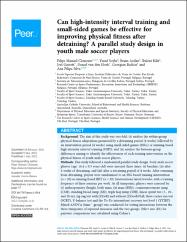| dc.contributor.author | Clemente, F.M. | |
| dc.contributor.author | Soylu, Y. | |
| dc.contributor.author | Arslan, E. | |
| dc.contributor.author | Kilit, Bülent | |
| dc.contributor.author | Garrett, J. | |
| dc.contributor.author | van, den, Hoek, D. | |
| dc.contributor.author | Silva, A.F. | |
| dc.date.accessioned | 2023-04-20T08:05:55Z | |
| dc.date.available | 2023-04-20T08:05:55Z | |
| dc.date.issued | 2022 | |
| dc.identifier.issn | 2376-5992 | |
| dc.identifier.uri | https://doi.org/10.7717/peerj.13514 | |
| dc.identifier.uri | https://hdl.handle.net/20.500.11776/11099 | |
| dc.description.abstract | Background: The aim of this study was two-fold: (i) analyze the within-group physical fitness adaptations promoted by a detraining period (4 weeks) followed by an intervention period (4 weeks) using small-sided games (SSGs) or running-based high intensity interval training (HIIT); and (ii) analyze the between-group differences aiming to identify the effectiveness of each training intervention on the physical fitness of youth male soccer players. Methods: This study followed a randomized parallel study design. Forty male soccer players (age: 16.4 ± 0.5 years old) were assessed three times: (i) baseline; (ii) after 4 weeks of detraining; and (iii) after a retraining period of 4 weeks. After returning from detraining, players were randomized to an SSG-based training intervention (n = 20) or running-based HIIT (n = 20). Interventions lasted 4 weeks, with a training frequency of three sessions per week. At all timepoints, players were assessed by: (i) anthropometry (height, body mass, fat mass (FM)), countermovement jump (CMJ), standing broad jump (SBJ), triple hop jump (THJ), linear sprint test (5-, 10-, and 20-m), zig-zag test with (ZZwB) and without (ZZwoB) ball, three corner run test (3CRT), Y-balance test and the Yo-Yo intermittent recovery test level 1 (YYIRT). Mixed ANOVA (time * group) was conducted for testing interactions between the three timepoints of repeated measures and the two groups. Effect size (ES) for pairwise comparisons was calculated using Cohen’s. Results: Between-group analysis revealed significantly smaller SBJ (t = ?2.424, p = 0.020, d = ?0.767 small ES) and THT (t = ?4.353, p < 0.001, d = ?1.376 large ES) in the SSG group after the retraining period. At the same time, SSG presented significantly greater FM after retraining compared to HIIT (t = 3.736, p < 0.001, d = 1.181 large ES). Additionally, SSG had significantly smaller values than HIIT in the ZZwB (t = ?3.645, p < 0.001, d = ?1.153 large ES), but greater times in the ZZwoB (t = 2.679, p = 0.011, d = 0.847 large ES) and 3CRT (t = 3.126, p = 0.003, d = 0.989 large ES). Conclusions: Although SSG and HIIT interventions improved physical fitness outcomes after a period of detraining, they were not able to effectively restore body composition, CMJ, 20-m sprint, ZZwB, and YYIRT compared with the baseline assessments (before detraining). Only HIIT was significantly effective for restoring SBJ, short linear sprin speed, and change-of-direction compared with baseline. HIIT was also significantly better than SSG in improving SBJ and ZZwoB. Although the small sample, the non determination of maturation status and the need to be cautious regarding generalization, HIIT appears to be more beneficial than SSG after a detraining period for recovery of body composition and physical fitness qualities in this specific context of youth soccer players. © Copyright 2022 Clemente et al. | en_US |
| dc.description.sponsorship | Fundação para a Ciência e a Tecnologia, FCT; Ministério da Ciência, Tecnologia e Ensino Superior, MCTES: UIDB/50008/2020 | en_US |
| dc.description.sponsorship | This work is funded by Fundação para a Ciência e Tecnologia/ Ministério da Ciência, Tecnologia e Ensino Superior through national funds and when applicable co-funded EU funds under the project UIDB/50008/2020. The funders had no role in study design, data collection and analysis, decision to publish, or preparation of the manuscript. | en_US |
| dc.description.sponsorship | The following grant information was disclosed by the authors: Fundação para a Ciência e Tecnologia/Ministério da Ciência. Tecnologia e Ensino Superior. EU funds: UIDB/50008/2020. | en_US |
| dc.language.iso | eng | en_US |
| dc.publisher | PeerJ Inc. | en_US |
| dc.identifier.doi | 10.7717/peerj.13514 | |
| dc.rights | info:eu-repo/semantics/openAccess | en_US |
| dc.subject | Athletic performance | en_US |
| dc.subject | Football | en_US |
| dc.subject | High-intensity interval training | en_US |
| dc.subject | Human physical condition | en_US |
| dc.subject | Physical fitness | en_US |
| dc.subject | Frequency modulation | en_US |
| dc.subject | Health | en_US |
| dc.subject | Sports | en_US |
| dc.subject | Athletic performance | en_US |
| dc.subject | Effect size | en_US |
| dc.subject | High intensity | en_US |
| dc.subject | High-intensity interval training | en_US |
| dc.subject | Human physical condition | en_US |
| dc.subject | Interval trainings | en_US |
| dc.subject | Physical conditions | en_US |
| dc.subject | Physical fitness | en_US |
| dc.subject | Soccer player | en_US |
| dc.subject | Training intervention | en_US |
| dc.subject | Testing | en_US |
| dc.title | Can high-intensity interval training and small-sided games be effective for improving physical fitness after detraining? A parallel study design in youth male soccer players | en_US |
| dc.type | article | en_US |
| dc.relation.ispartof | PeerJ Computer Science | en_US |
| dc.department | Fakülteler, Spor Bilimleri Fakültesi, Spor Yöneticiliği Bölümü | en_US |
| dc.identifier.volume | 10 | en_US |
| dc.institutionauthor | Kilit, Bülent | |
| dc.relation.publicationcategory | Makale - Uluslararası Hakemli Dergi - Kurum Öğretim Elemanı | en_US |
| dc.authorscopusid | 57209913336 | |
| dc.authorscopusid | 57210283210 | |
| dc.authorscopusid | 55750386500 | |
| dc.authorscopusid | 57190220728 | |
| dc.authorscopusid | 57203573415 | |
| dc.authorscopusid | 57160528200 | |
| dc.authorscopusid | 57191271492 | |
| dc.identifier.scopus | 2-s2.0-85136094870 | en_US |



















